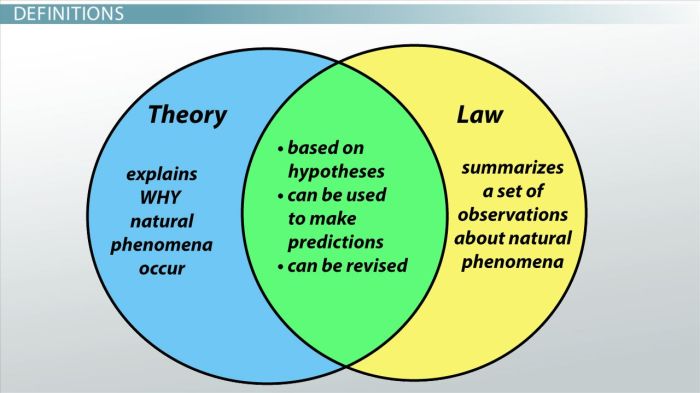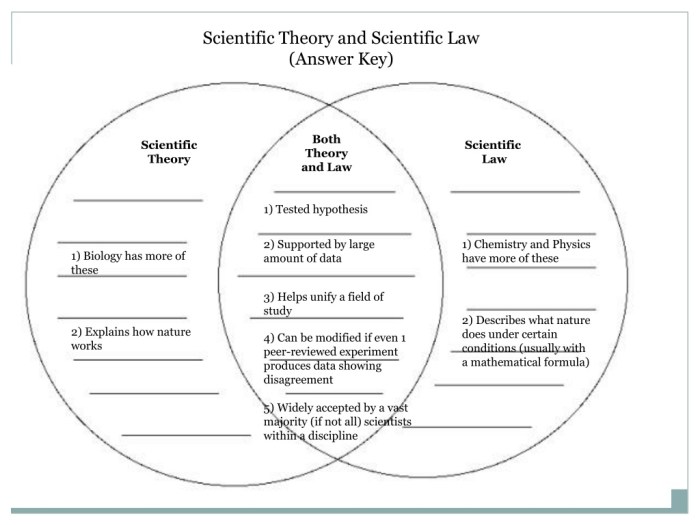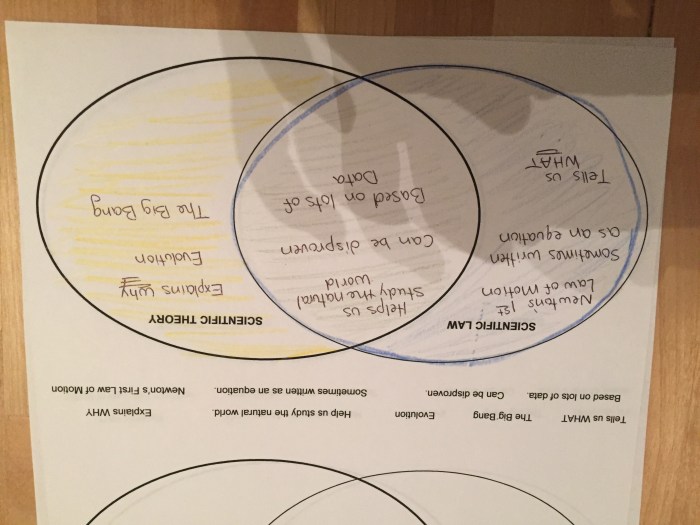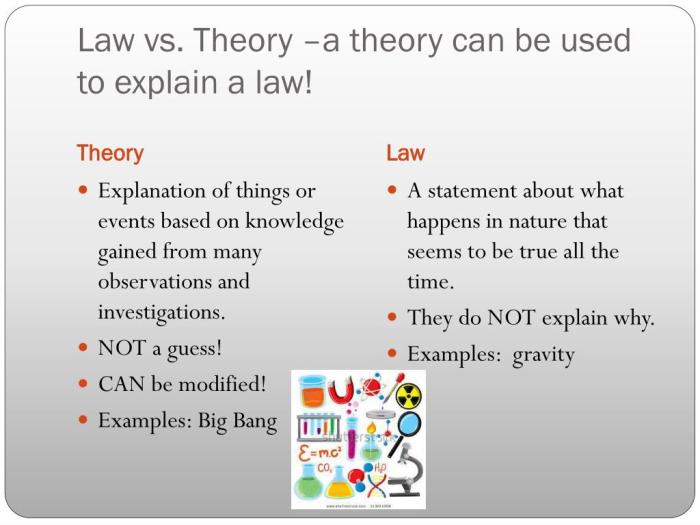Welcome to the captivating realm of theory vs law venn diagram, where we delve into the intriguing relationship between these two fundamental concepts. As we explore their similarities, differences, and dynamic interplay, get ready to witness the sparks fly in this enlightening discourse.
Theory, the realm of abstract ideas and principles, and law, the embodiment of codified rules and regulations, may seem worlds apart. Yet, their paths intertwine in fascinating ways, shaping our understanding of the world and our place within it.
Theoretical and Legal Framework

In any scientific discipline, theories and laws are two fundamental components that provide a framework for understanding and explaining various phenomena. While they share some similarities, there are also key differences between theory and law that shape their roles and applications in the field of science.
Concept of Theory
A theory is a well-substantiated explanation of some aspect of the natural world that is acquired through the scientific method. It is based on a body of evidence that has been repeatedly tested and confirmed through experimentation and observation. Theories provide a framework for organizing and interpreting data, and they make predictions about the behavior of the natural world.
A Venn diagram comparing theories and laws might help clarify the differences between the two. For instance, Swot Analysis For Toms Shoes illustrates how SWOT analysis can be used to assess a company’s strengths, weaknesses, opportunities, and threats. Understanding the distinctions between theories and laws is crucial because it enables us to critically evaluate the validity and applicability of various ideas.
Concept of Law, Theory vs law venn diagram
A law, on the other hand, is a statement that describes a natural phenomenon that has been observed to occur repeatedly under the same conditions. Laws are typically based on empirical evidence and are expressed in the form of mathematical equations or statements.
They describe the relationships between variables and can be used to predict the behavior of a system under specific conditions.
Similarities and Differences
Both theories and laws are based on evidence and are used to explain and predict natural phenomena. However, there are some key differences between the two. Theories are more general and , while laws are more specific and descriptive. Theories provide a framework for understanding why something happens, while laws describe how something happens.
Additionally, theories are subject to revision and refinement as new evidence is acquired, while laws are typically more stable and unchanging.
Overlapping and Intersecting Areas

The intersection of theory and law represents the areas where they overlap and interact. In these areas, theory provides the foundation for legal principles, while law shapes the development and application of theory.
One key area of overlap is in the realm of legal reasoning. Legal scholars and practitioners use theories to interpret statutes, analyze case law, and develop arguments. For example, the theory of strict liability provides a framework for determining legal responsibility in tort cases, regardless of intent.
Interplay between Theory and Law
- Theories inform legal principles:Theories provide the conceptual foundation for legal rules and doctrines. For instance, the theory of natural law has influenced the development of constitutional principles and human rights protections.
- Law shapes theoretical development:Legal cases and statutes can challenge and refine theories. Empirical research on legal outcomes can provide evidence to support or refute theoretical propositions.
- Theories guide legal reform:Theoretical insights can inform the design and implementation of legal policies and reforms. For example, the theory of deterrence has been used to justify the use of harsh criminal penalties.
Distinct and Non-Overlapping Areas: Theory Vs Law Venn Diagram

While theory and law overlap in some areas, there are also distinct areas where they do not intersect. These non-overlapping areas arise due to fundamental differences in their nature and purpose.
One of the primary reasons for non-overlapping areas is the inherent abstractness of theory. Theories provide conceptual frameworks and explanations, often based on assumptions and generalizations. They aim to understand and explain phenomena, but they may not always have a direct or immediate application in the practical world.
Theoretical Considerations
- Conceptual frameworks:Theories establish abstract models and frameworks that represent the underlying mechanisms and relationships within a particular domain.
- Assumptions and generalizations:Theories often rely on assumptions and generalizations to simplify complex phenomena, which may not always hold true in all real-world situations.
- Predictive capabilities:While theories may provide predictions, their accuracy can vary depending on the complexity and variability of the system being studied.
Legal Considerations
- Practical application:Laws are designed to be practical and enforceable, providing specific rules and regulations that govern behavior and resolve disputes.
- Enforcement mechanisms:Laws are backed by enforcement mechanisms, such as courts and penalties, to ensure compliance.
- Specificity and precision:Laws are typically specific and precise, aiming to provide clear guidance on what is permissible and what is prohibited.
Venn Diagram Representation

A Venn diagram is a graphical representation that illustrates the relationship between two or more sets. In this case, we use a Venn diagram to visually represent the relationship between theory and law.
The diagram consists of two overlapping circles, one representing theory and the other representing law. The overlapping area represents the intersection between theory and law, while the non-overlapping areas represent the distinct and non-overlapping areas of theory and law.
The overlapping area represents the areas where theory and law intersect and interact. This includes areas such as the use of theory to inform law-making, the use of law to test and refine theory, and the use of theory to interpret and apply law.
Implications and Applications

Understanding the relationship between theory and law has significant implications for various fields and contexts. It enables us to:
Identify the theoretical underpinnings of legal principles and practices.
Develop new legal frameworks based on sound theoretical foundations.
Analyze and evaluate the effectiveness of legal systems in achieving their intended goals.
Applications in Law and Policy
In law and policy, understanding the theory-law relationship helps policymakers:
- Craft laws based on evidence-based research and theoretical principles.
- Evaluate the potential impact of proposed laws before implementation.
- Identify and address gaps in existing legal frameworks.
Questions and Answers
What is the key difference between theory and law?
Theory provides a conceptual framework for understanding phenomena, while law establishes binding rules that govern behavior.
How do theory and law influence each other?
Theory can inform law by providing justification and principles, while law can shape theory by testing and refining its propositions.
